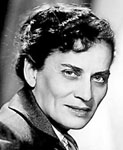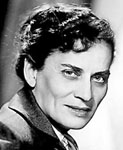
Faces & TracesGabrielle Roy, English Canadians’ favorite French Canadian [Archives:2008/1128/Culture]
February 11 2008
 |
Canadian novelist, short story writer and journalist Gabrielle Roy was born March 22, 1909, in Saint Boniface, Manitoba, a small French-speaking community that is now part of Winnipeg.
Her father was a federal colonization agent working to resettle immigrants in western Canada. He lost his job in 1913 a few months before he would have qualified for retirement, leaving his family in dire straits, so Roy's mother took in sewing projects to keep the family afloat.
Roy's childhood as a poor Francophone Manitoban forced her to work hard at school, where she won prizes for work in both French and English. The money she won for her final examination results paid for her first year at Winnipeg Normal Institute, where she enrolled in 1927.
Obtaining her teaching certificate in 1929, she began teaching school in the backwoods of Manitoba, all the while continuing to contribute her wages to her family for years. Throughout her teaching years, Roy was a member of a drama troupe, Le Cercle Moli're.
She left home in 1937 with her small savings to study dramatic art in England and France for two years. However, the 1939 outbreak of World War II hastened her return to Canada where she settled in Montreal, Quebec, becoming a freelance journalist.
For the next six years in Montreal, Roy produced both journalism and short stories for Canadian publications such as Le Jour and Le Bulletin des Agricultures and the literary journal, La Revue Moderne.
Following her marriage in 1947, Roy moved with her husband to live in Paris for the next three years. They returned to LaSalle, a city on Montreal Island, in 1950, settling two years later in Quebec City.
Considered one of the most important Francophone writers of the postwar era in Canadian history, some of Roy's works being translated into 15 languages.
Throughout her prolific career, she received many honors, including three Governor General's Awards (in 1947, 1957 and 1978), the 1956 Duvernay Prize, the 1968 Medal of the Canada Council, the 1970 Athanase-David Prize, the 1971 David Prize, the 1978 Molson Prize and the Canada Council's 1980 prize for children's literature.
Additionally, Roy was the first woman to become a fellow of the Royal Society of Canada in 1947 and was made Companion of the Order of Canada in 1967.
The central theme of Roy's work is that of humanity in pain and solitude, but redeemed by the love implicit in creation and by hope for a world in which all human beings are reconciled.
Roy's novels are both urban and rural, with some set in Montreal, while others are on the prairies of her youth, and one book is set in the Canadian north.
Additionally, her novels and short stories frequently are included in high school curricula, either in their original French or in English translation.
Roy's first novel, “Bonheur d'occasion” (1945; The Tin Flute, 1947), is considered a masterpiece of social realism. The novel innovatively portrays the urban environment of Montreal and its poverty-stricken working-class neighborhood, Saint-Henri, during World War II.
“The Tin Flute” was the first Canadian novel to win both France's Prix Femina and New York's Literary Guild Award in 1947 and it was made into a critically acclaimed movie in 1983.
Roy's second novel, 1950's “La Petite Poule d'Eau” (Where Nests the Water Hen, 1951), is set in the isolated area of northern Manitoba where Roy taught school in 1937. It presents a tender and idyllic portrait of a rural life of innocence and harmony away from the demands and temptations of the wider world. The novel became a stable for English Canadian school children to read in their French language classes.
The dark and emotional story, “Alexandre Chenevert,” (The Cashier, 1955) is ranked as one of the most significant works of psychological realism in the history of Canadian literature.
Roy's other fictional works include “Rue Deschambault” (Street of Riches, 1957), “La Montagne Secr'te,” (The Hidden Mountain, 1962) which was set in the Canadian Arctic, “La Route d'Altamont” (The Road Past Altamont, 1966), “Cet Ete qui Chantait” (Enchanted Summer, 1976) and “Un Jardin au Bout de Monde” (Garden in the Wind, 1977).
Her 1977 novel, “Ces Enfants de Ma Vie” (Children of My Heart, 1979) depicted her evident love for children and the happiness she received from teaching. Adapted into a television film in 2000, its English translation was selected for inclusion in the 2007 edition of Canada Reads.
In 1978, Roy published a collection of non-fiction writing spanning her entire life in her book, “Fragile Lumi'res de la Terre” (Fragile Lights of the Earth). She also penned three volumes of children's stories: “Ma Vache Bossie” (My Cow Bossie, 1988), “Courte-Queue” (Cliptail, 1980) and “L'Espanole et Le Pekinoise” (The Tortoiseshell and the Pekinese, 1989).
Entitled “La Detresse et L'Enchantement” (Enchantment and Sorrow) and covering the years from her childhood in Manitoba to the time when she settled in Quebec, her autobiography was published posthumously in 1984.
Roy died of a heart attack on July 13, 1983 in Quebec City. The recognition won by her immense talent opened new vistas for Francophone writers in Canada. Perhaps her exemplary work and analysis of the human condition were possible due to the fact that her life was filled with both enchantment and sorrow.
——
[archive-e:1128-v:15-y:2008-d:2008-02-11-p:culture]


